#wildlife conservation
Text
"When considering the great victories of America’s conservationists, we tend to think of the sights and landscapes emblematic of the West, but there’s also a rich history of acknowledging the value of the wetlands of America’s south.
These include such vibrant ecosystems as the Everglades, the Great Dismal Swamp, the floodplains of the Congaree River, and “America’s Amazon” also known as the “Land Between the Rivers”—recently preserved forever thanks to generous donors and work by the Nature Conservancy (TNC).
With what the TNC described as an “unprecedented gift,” 8,000 acres of pristine wetlands where the Alabama and Tombigbee Rivers join, known as the Mobile Delta, were purchased for the purpose of conservation for $15 million. The owners chose to sell to TNC rather than to the timber industry which planned to log in the location.
“This is one of the most important conservation victories that we’ve ever been a part of,” said Mitch Reid, state director for The Nature Conservancy in Alabama.
The area is filled with oxbow lakes, creeks, and swamps alongside the rivers, and they’re home to so many species that it ranks as one of the most biodiverse ecosystems on Earth, such that Reid often jokes that while it has rightfully earned the moniker “America’s Amazon” the Amazon should seriously consider using the moniker “South America’s Mobile.”
“This tract represents the largest remaining block of land that we can protect in the Mobile-Tensaw Delta. First and foremost, TNC is doing this work for our fellow Alabamians who rightly pride themselves on their relationship with the outdoors,” said Reid, who told Advance Local that it can connect with other protected lands to the north, in an area called the Red Hills.
“Conservation lands in the Delta positions it as an anchor in a corridor of protected lands stretching from the Gulf of Mexico to the Appalachian Mountains and has long been a priority in TNC’s ongoing efforts to establish resilient and connected landscapes across the region.”
At the moment, no management plan has been sketched out, but TNC believes it must allow the public to use it for recreation as much as possible.
The money for the purchase was provided by a government grant and a generous, anonymous donor, along with $5.2 million from the Holdfast Collective—the conservation funding body of Patagonia outfitters."
youtube
Video via Mobile Bay National Estuary Program, August 7, 2020
Article via Good News Network, February 14, 2024
#united states#alabama#estuary#wetlands#swamp#river#environment#environmental issues#conservation#video#biodiversity#american south#ecosystems#ecology#conservation news#wildlife conservation#ecosystem#conservation efforts#good news#hope#forest#swampco#re#Youtube
2K notes
·
View notes
Text
Unsurprisingly, a lot of the commentary I'm seeing about this has been of the "But--but--I would do the same thing because I don't want anything bad to happen to the deer!"
Look. I love wildlife, and I love getting to see deer, coyotes, and even the occasional black bear in my neighborhood. But they are here because there is good habitat nearby with lots of natural food sources, not because I deliberately put out food for them to eat. I respect them as wild animals with whom my relationship is very different compared to the domesticated animals I take care of every day. A deer is not a sheep or a horse; a coyote is not a dog.
People who do things like try to tame deer or, worse yet, try to raise a fawn or other young wildlife like pets are robbing those wild animals of their natural existences. We've already wrought our own preferences on the landscape to a severe degree, tearing the wildness out of it to create lawns and farms and subdivisions and strip malls. When we then dismiss the wildness of these animals and impress our own desire for connection on our terms on them, we are harming them.
I've already written elsewhere about the difference between "tame" and "domesticated". No matter how docile that deer seems, it is never going to be as (relatively) safe and tractable as a domesticated sheep or goat. It will always be more unpredictable, and more likely to lash out suddenly at a person due to fear, or hormones, or protection of young.
These animals need their wild instincts to be intact if they are going to survive without being dependent on us. They need those instincts in order to find mates and keep the gene pool stirred up. Their instincts keep them safe from danger, including humans. And their instincts never totally go away, no matter how much we may try to tame them otherwise.
This is why a good wildlife rehab is going to minimize handling of the wild animals they care for, especially those that are going to be able to be released back into the wild. The less comfortable these animals are with humans, the better their chances of surviving in the wild and having fulfilling, natural lives. Wildlife that retain their wariness of humans are less likely to end up falling prey to hunting, or being killed as nuisance animals when they get too aggressive in seeking food or otherwise coming into conflict with people.
The person who painted "pet" on a fully grown white-tailed buck and put a collar around his neck may have felt like they were doing that deer a kindness, but they have likely robbed him of the chance to just live a natural life as his own, independent being out in the woods and fields. He might be out there, sure, but perhaps he won't mate because he imprinted on humans. Or maybe he will end up shot by a hunter in spite of the precautions because he's just too friendly and those antlers are worth taking the shot.
There will always be something missing from this deer's life because of the arrogance of someone who thought they could own and keep and control a wild-born animal for their own enjoyment, instead of allowing him to come and go as he pleased. Honestly, it reminds me of King Haggard from Peter S. Beagle's The Last Unicorn, whose response to seeing something beautiful was to capture it and keep it rather than simply enjoying and remembering that magical moment:
"I like to watch them. They fill me with joy. The first I felt it I thought I was going to die. I said to the Red Bull I must have them, all of them, all there are. For nothing makes me happy but their shining and their grace. So the Red Bull caught them. Each time I see the unicorns, my unicorns, it is like that morning in the woods and I am truly young, in spite of myself."
That's how I feel about people who are willing to drastically alter a wild animal's behavior for their own selfish benefit, even if they think they're being kind. I know I'm fighting a bit of an uphill battle in this, but I'm rather stubborn that way.
#deer#wildlife#wild animals#nature#animal welfare#animal cruelty#hunting#white tailed deer#zoology#animal behavior#ecology#environment#conservation#wildlife conservation#feeding wildlife#pets#animals#The Last Unicorn
1K notes
·
View notes
Text

7K notes
·
View notes
Text
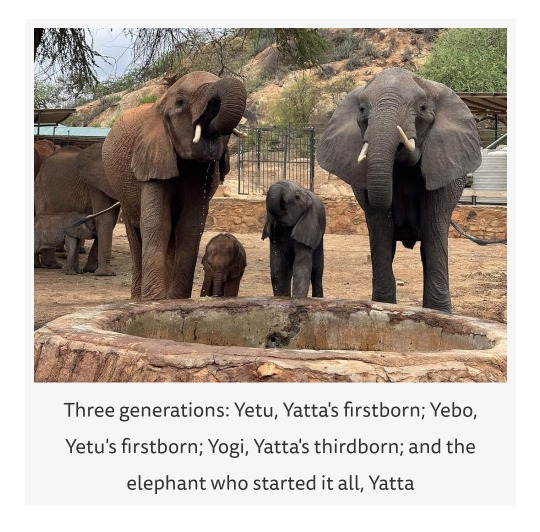
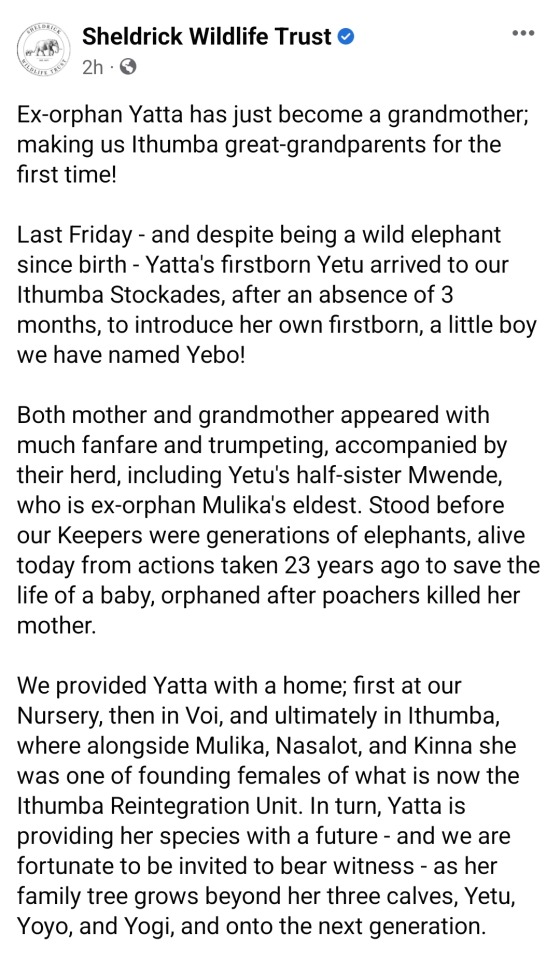
This is just SO cool and so cute!!! Sheldrick Wildlife Trust, a wildlife & conservation organization, is celebrating their first "great-grand-baby" elephant! One of their many programs is raising orphan wildlife, primarily elephants. Their program has been going for over 5 decades! They discovered the right formula to sustain milk-dependent baby elephants, and I believe rhinos as well.
This year they've reached 52 calves born to ex-orphans in the wild, which is absolutely amazing. But now they have their first one born to one of THOSE calves, making ex-orphan Yatta a grandmother!
Here's the longer blog post with the stories for this amazing elephant family. This bit at the end made me cry -

@hope-for-the-planet this seems like your kind of post!!
#wildlife#wildlife conservation#elephants#wildlife rescue#conservation#i love following this organization#they have so many cool programs#including education and community support#which are so so integral to conservation efforts#this is just so cool for them
3K notes
·
View notes
Text
Friendly reminder to "outdoor cat" proponents that the common housecat (felis catus) is on the list of top 100 most dangerous invasive alien species and are listed as a worldwide threat.
Friendly reminder that the common housecat (felis catus) are credited with the extinction of at least 33 species of wildlife globally, primarily birds, small reptiles, and rodents.
Friendly reminder of all the hazards that exist out in the world including diseases, other animals, humans, cars, environmental dangers, and so on.
Friendly reminder that domesticated species are not suited to natural environments and can not support or defend themselves.
Friendly reminder that negligence is a form of animal cruelty.
Keep your cats indoors. I don't care that you think your cat is so much happier outside. I don't care that you think he's living a fuller life by being able to massacre local fauna. Either keep him inside and enrich him properly like a good pet owner, or rehome him to someone who can and never own an animal again. This is non-negotiable.
#baph bleats#wildlife conservation#invasive species#theyre called 'house cats' for a reason#keep that beast indoors
923 notes
·
View notes
Text
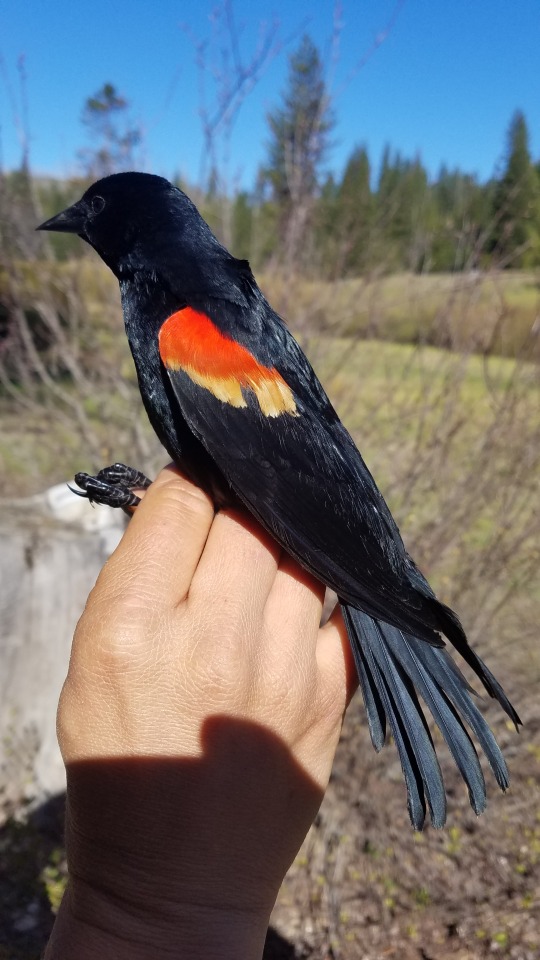
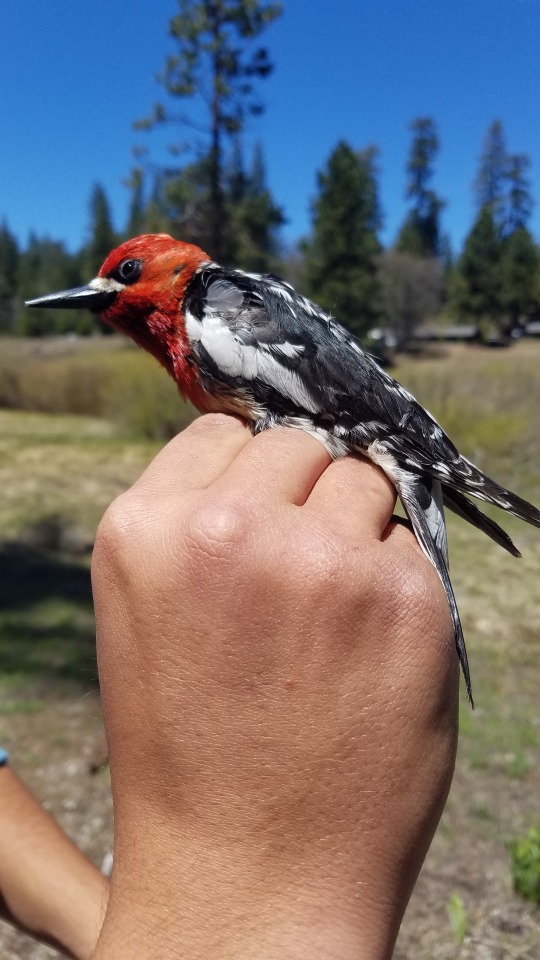

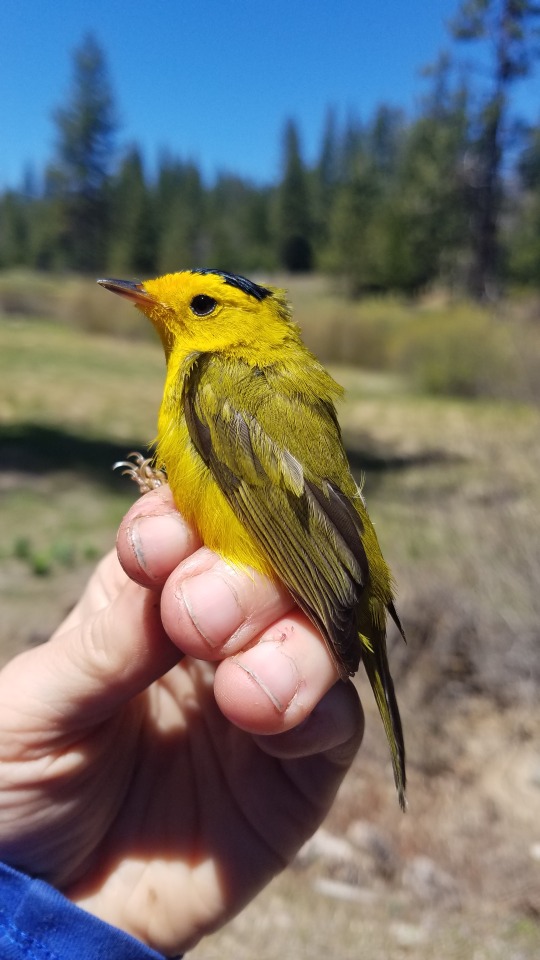

Hey all! I don't typically post my photos here but heck, I should. This is just a heads up that you won't see much from me for the next couple weeks as I go on my yearly fieldwork trip to Yosemite to train our summer bird banding crew in how to run their stations. These MAPS (Monitoring Avian Productivity and Survivorship) stations are part of a long-term (30+ years!) monitoring project that has resulted in some amazing science, from teaching us about how climate change affects birds at different altitudes to setting new longevity records (we have a 20-year old woodpecker!).
All of this is done through The Institute for Bird Populations. Go check out the website and learn more about what we do for birds around the world!
#birdblr#ornithology#birds#birb#borb#songbirds#red-winged blackbird#red-breasted sapsucker#macgillivray's warbler#wilson's warbler#yosemite#yosemite national park#science#wildlife conservation
785 notes
·
View notes
Text
#conservation#animal conservation#wildlife#wildlife conservation#Australia conservation#reintroduction#biodiversity#good news#animal#platypus#hope#environment#ecoanxiety#environmental grief
670 notes
·
View notes
Text

Red river hog studies. (4-26-23)
These guys are really cute- they've got little tassels on their ears!!!
#art study#digital art#digital sketch#pigs#wild hogs#wild boar#boar#wildlife conservation#red river hog#bushpig#thats not a euphemism#to my knowledge#sketch#sketches#piglet
501 notes
·
View notes
Photo
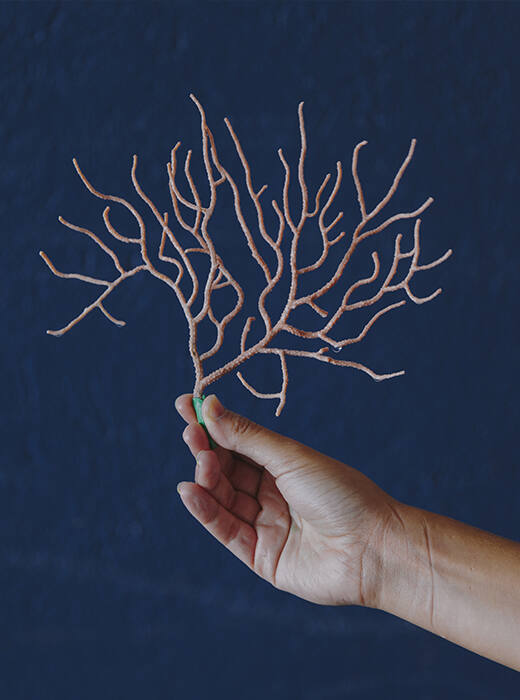
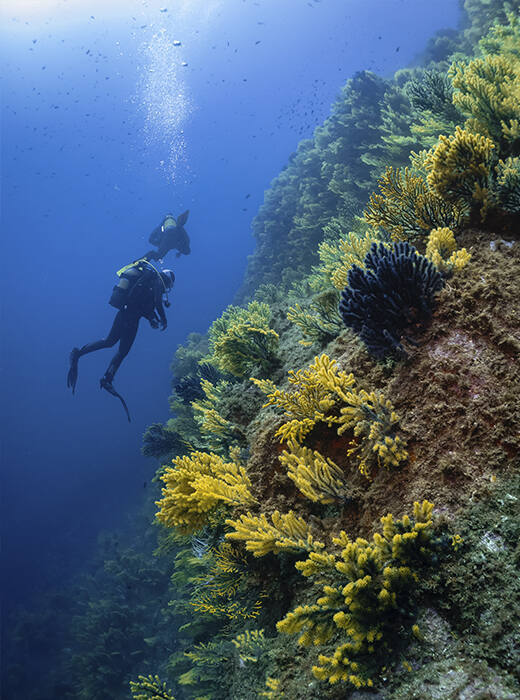
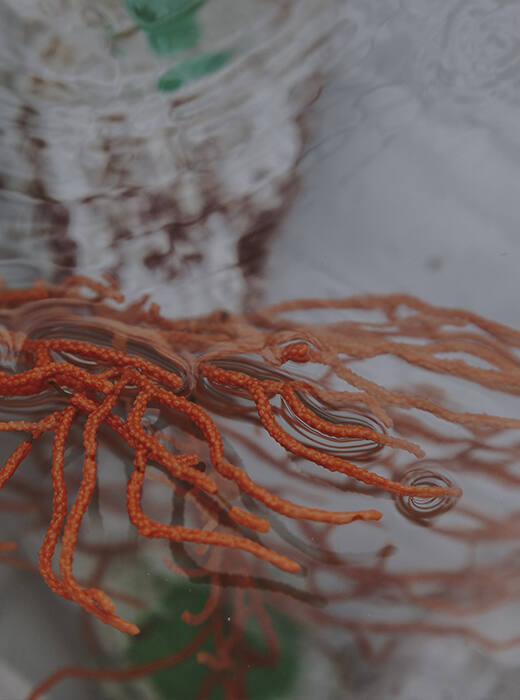
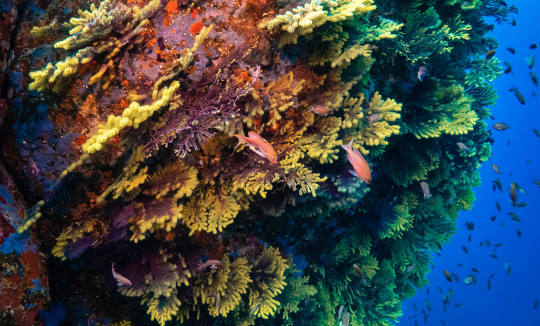
Gorgonias in the Mediterranean coast of Cap de Creus Natural Park (Comarques Gironines, Catalonia).
“The disappearance of gorgonias can cause a chain reaction that will affect the entire Mediterranean ecosystem” - Janire Salazar, Marine biologist from ICM - CSIC.
Gorgonias are organisms that make up entire underwater forests: areas in which many other species go to shelter, breed and grow. Mediterranean gorgonias currently suffer the daily impact of traditional fishing methods like gillnets. And like in any other forest, if the elements that make it up are not protected, the wildlife that it harbours will disappear. The ResCap project, which is carried out by ICM – CSIC, Fundación Biodiversidad and the fishermen’s associations of Port de la Selva and Cadaqués, aims to protect and recover all deep-sea gorgonias found in the Cap de Creus Natural Park.
Gorgonias are marine organisms which, despite the way they look, are not plants or algae, but animals. They are stationary, live in depths of more than a hundred meters, show very slow growth and take many years to recover. They are vulnerable, but great biodiversity depends on their growth. “Gorgonias are a structural species to the Mediterranean ecosystem, as they favour the growth and survival of multiple species,” says Marina Biel, one of the biologists from CSIC involved in the project.
Biologists, fishermen and agents from the Cap de Creus Natural Park work together to rescue all those gorgonias that have been accidentally trapped in fishing nets. Once recovered, the gorgonias are taken to the lab’s experimental aquariums to be studied and treated before they are freed again. When they are ready to go back to the marine environment, they are affixed to a base made of stone so that its weight will create the so-called “badminton effect” when they are released back into the sea. “The badminton effect ensures that the gorgonia will land on its feet on the seafloor and will therefore be able to feed itself and survive with no problems,” Marina Biel says.
The Pleamar projects bring to the forefront how important it is for biologists and fishermen to work together on the restoration of sea floors and the preservation of an essential species for the Mediterranean ecosystem: gorgonias. “Both parties work towards the same goal: to protect the sea floor and its biodiversity,“ ICM - CSIC biologists Janire Salazar and Marina Biel point out. Salvador Manera, a fisherman from the fishermen’s association of Port de la Selva and driving force of other sustainable projects linked to the Mediterranean, highlights how valuable these synergies will be into the future: “They help to raise awareness and to make us understand that we need to fish in a sustainable way if we want to carry on doing our job.”
Over the first year of the project (2018), more than 400 gorgonias were released back into the sea, with a survival rate above 90%. All parties involved hope to match or improve these results in 2019, as they also help to raise awareness about these kinds of initiatives. “There is an increasing number of people who are interested in marine conservation projects,” Janire and Marina say, as they insist on the meaning behind these actions: “The actions you take today will be rewarded tomorrow. It’s about giving something in return for the great things that the sea gives us each day.”
Shared from: Pleamar Projects: RESCAP & MITICAP. Institut de Ciències del Mar through Estrella Damm.
#natura#cap de creus#catalunya#marine conservation#marine biology#gorgonia#mediterranean#catalonia#sea#ocean#biology#biodiversity#wildlife#earth#ecology#sustainability#environment#conservation#wildlife conservation#marine life
253 notes
·
View notes
Text

INTERNET DRUID
Zoology & Botony Druidposting
Animal Care Tech
Ungulate Enthusiast

Please Consider Helping!
Arab.org
Palestine Children's Relief Fund
Anera
Medical Aid for Palestinians
Rainforest Trust
Center for Biological Diversity
National Wildlife Federation
Just Diggit
Wildlife Conservation Network

Mailbox: Open!
Send a 🥚 to be assigned a animal
Send a 🐌 to be assigned a bug
Send a 🌱 to be assigned a plant

67 notes
·
View notes
Text
#Repost @sheldricktrust
"Bedtime for the Nursery herd! The orphans know which stable is theirs and need no directions — after a day of adventuring in Nairobi National Park, everyone is ready for a good night’s sleep. The youngest babies approach bedtime with the most gusto, dashing home in a frenzy of flapping ears, pumping legs, and flailing trunks. In order of appearance here, we have Pardamat in the lead, followed by Mzinga, Nyambeni, Muridjo, Talek, and Shujaa bringing up the rear.
These are some of the youngest orphaned elephants currently in our care. You can become part of their journey through an adoption, helping to fund the round-the-clock care they need to thrive. To learn more, tap our link in bio or visit:
sheldrickwildlifetrust.org/orphans
© Sheldrick Wildlife Trust
45 notes
·
View notes
Text
The population of giant pandas in the wild has nearly doubled as China steps up its conservation efforts.
China’s National Forestry and Grassland Administration said on Jan 25 there are now around 1,900 pandas in the wild from some 1,100 in the 1980s.
This has been due to China’s efforts to protect the species, considered a national treasure, said Mr Zhang Yue, an official with the administration.
The Giant Panda National Park was established in October 2021, covering a total area of over 22,000 sq km and providing a home to around 72 per cent of the wild giant panda population.
Protected areas for giant pandas have grown from 1.39 million ha to 2.58 million ha since 2012.
The International Union for Conservation of Nature has adjusted the status of giant pandas from “endangered” to “vulnerable”.
“This indicates that China’s giant panda conservation efforts have been recognised by the international wildlife conservation community,” Mr Zhang said.
The global captive population of giant pandas, meanwhile, has now reached 728, with 46 pandas successfully bred in captivity in 2023.
The genetic diversity of captive giant pandas has also improved. The current captive population of giant pandas can maintain 90 per cent genetic diversity for up to 200 years.
As for giant pandas living abroad, Mr Zhang said China has organised field inspections and assessments of 23 overseas cooperation institutions in 19 countries since 2023.
“The cooperation institutions generally meet the requirements in terms of venue construction, feeding and nursing, and disease prevention and control measures,” Mr Zhang said, adding that pandas living abroad are generally “in good health”.
He said China will further improve the international cooperation management mechanism for giant pandas, carry out regular daily health monitoring and field inspection and assessment, and continue to strengthen cooperation with international partners for the protection of endangered species and biodiversity.
-via The Straits Times, January 25, 2024
#panda#panda bear#pandas#china#endangered species#conservation#conservation news#conservation efforts#conservation practices#ecology#wildlife conservation#zoo animals#zoology#wildlife#wild animals#national park#giant panda national park#icun#good news#hope#hopepunk
990 notes
·
View notes
Text
If you've been following me for a while, you'll know I'm a sucker for stories about species reintroductions, rediscoveries, etc. And this one might be my favorite this year.
The kākāpō is this delightfully odd bird--a nocturnal, ground-dwelling parrot. Because New Zealand historically didn't have any predators apart from birds of prey, their camouflage was generally sufficient to protect them in the forest. Unfortunately, Europeans brought with them weasels, rats, and free-roaming cats, all of which hunted the kākāpō to the brink of extinction. Invasive species of deer additionally competed with the kākāpō for food.
By the 1980s, the birds had all but disappeared from the main island, and the world population bottomed out at 51 birds in 1995. Since then, breeding efforts and conservation on smaller, predator-free islands have brought the population back up to 252, but this is still a critically endangered species.
The reintroduction to the main island involved setting aside 3400 acres in which all mammalian predators had been eliminated. That would allow the kākāpō a safe place to breed and recover. Right now the four birds released into this sanctuary are all male, to allow conservationists a chance to observe them in this habitat. With time, though, we'll hopefully see females added as well, so that the population can begin expanding.
(By the way, yes--this is, in fact, the species in the infamous "shagged by a rare parrot" clip from the BBC's "Last Chance to See" series some years back. Don't worry, it's less NSFW than it sounds, and it is absolutely hilarious!)
#kākāpō#kakapo#parrots#birds#wildlife#nature#optimism#hopepunk#conservation#environment#environmentalism#endangered species#extinction#animals#ecology#restoration ecology#wildlife conservation#Psittaciformes#psittacines
567 notes
·
View notes
Photo
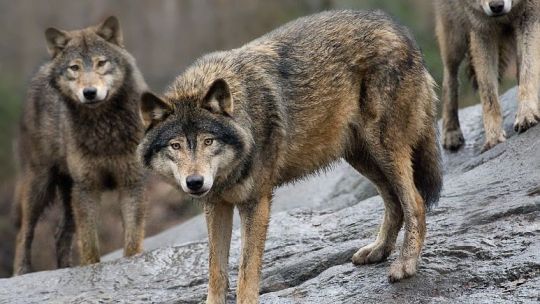
Sweden’s biggest, controversial endangered wolf cull has started but campaigners fight on
February 2023 - Hunters have already shot dead 54 wolves in Sweden’s largest ever cull, while scientists warn that wolf numbers are not large enough to sustain a healthy population
Hunters have shot dead 54 wolves in a month in Sweden’s largest and most controversial cull of the animals yet, prompting fury from conservationists and satisfaction among farmers who consider the predators a threat to their livelihoods.
The Stockholm government has authorised the shooting of 75 wolves in its 2023 cull, more than twice last year’s figure, despite warnings from scientists that wolf numbers are not large enough to sustain a healthy population.
“Wolves are a threat for those of us who live in rural areas,” said Kjell-Arne Ottosson, a Christian Democrat MP and vice-president of the parliament’s environment and agriculture committee. “We have to manage that. We have to take this seriously.”
Farmers say more than 340 sheep were killed in 2021 by a Swedish wolf population estimated at about 460. The predators, which in the 1960s were thought to be extinct in Sweden, are also resented by hunters, who say the dogs they use to track and drive deer and elk are regularly attacked.
“This cull is absolutely necessary to slow the growth of wolves. Sweden’s wolf population is the largest we have had in modern times,” Gunnar Glöersen, predator manager at the Swedish Hunters’ Association, told public broadcaster SVT.
However, the scale of this year’s planned cull – only 203 wolves have been shot in total in Sweden in the 12 years since authorised hunting resumed – has alarmed conservationists. “It’s tragic,” said Daniel Ekblom of the Nature Conservation Society. “It could have consequences for a long time to come.”
Scientists have said that to sustain a healthy population, the wolf population roaming Sweden and Finland should not fall below 500, and Sweden’s Environmental Protection Agency has said at least 300 are necessary to avoid harmful inbreeding.
Led by centre- and far-right parties, however, Sweden’s parliament voted two years ago to cap the wolf population at 270, while the Swedish Hunters’ Association wants to go even further and lower the limit to 150 animals.
Wolf numbers fell steeply in Sweden after 1789, when a law was passed allowing commoners to hunt. That led to the decimation of the deer and elk populations, prompting wolves to prey more on livestock – and the state to pay a bounty for every wolf killed.
The population shrank to the brink of extinction and the predator was declared a protected species in the 1960s. Numbers began growing again 20 years later, however, when three wolves from the Russian-Finnish population migrated to central Sweden.
Conservation organizations in the country have attempted to overturn the wolf hunting mandate but have been unsuccessful.
Groups used the Bern Convention as their main argument. An international treaty agreed upon in 1979, the convention seeks to protect both wildlife and their habitats. Actions to do so are taken in the name of conservation.
“Wolves as top predators in the food chain are a prerequisite for biodiversity. Killing a quarter of the population through hunting has negative consequences for animals and nature,” Marie Stegard, president of Swedish anti-hunting group Jaktkritikerna told the Guardian.
“It’s disastrous for the entire ecosystem. The existence of wolves contributes to a richer animal and plant life. Human survival depends on healthy ecosystems.”
The European Commission has previously opened infringement proceedings against Sweden, warning that the annual cull falls foul of the EU’s habitats directive since “the wolf population has not reached a level that guarantees its conservation”.
“It’s astonishing that Sweden keeps on making these decisions,” said Marie Stegard Lind of the anti-hunting group Jaktkritikerna. “The commission has been very clear about its opinion that these hunts are, in fact, illegal,” Lind told AFP.
This year’s cull began in early January and ends on 15 February, although several regional authorities have already called it off having reached their quota. Experts have said the government’s planned national total of 75 wolves may not be reached.
Under pressure from farmers and hunters, the government authorised limited annual culls again in 2010. Since then, the wolf “has become a symbol of the conflict between the city and rural areas”, Johanna Sandahl of the Nature Conservation Society told AFP.
Sources: [x], [x]
#wolf#wolves#wildlife#animals#wildlife conservation#sweden#news#article#hunt#cull#trigger warning#population control
283 notes
·
View notes
Note
Hey- I was wondering if there's any way I can help/contribute to the effort to end/change wild caught trade? I would love to be a part of something so cool
I'M SO GLAD YOU ASKED. Thank you for activating info dump mode, I hope you enjoy your experience!
There are SO many ways to help work towards changing/ending hermit crab wild capture. Some may not seem as connected as others, but they all help with the overall goal of educating people about hermit crabs, valuing them, and respecting nature.
The more we can teach people that they shouldn't be cheap "disposable" pets, that they can live for decades instead of months, and how the wild caught trade is decimating populations, the less demand there will be for it. Play to your strengths and do what you can. Even small things make a difference!
(This post will have a ton of links, so please share since it'll probably get blocked from tags!)
Casual Advocating
- share a cool fact with class or with your friends! "Hermit crabs can live over 40 years" "Hermit crabs can lose legs due to stress, but can grow them back when molting" "Hermit crabs live in the ocean as zoea (babies) for up to a month before they become land hermit crabs" ...I could go on & on. 😂
- Remind friends & family not to bring hermit crabs home from beach shops, & not to take shells off the beach. Sometimes they have marine hermits in them, even if they look empty. These crabs will die without an established saltwater aquarium or being returned to the beach.
- Know someone interested in getting hermit crabs? Try to gently steer them away from pet stores & tell them about Land Hermit Crab Owners Society's adoption program! Or if they already have crabs, ask if they've heard of LHCOS & Crab Street Journal (original site), or send them to the websites or Facebook group for science-backed care info.
- If you know a teacher who wants to get a classroom pet, or maybe already has some crabs as classroom pets, tell them about the Claws in the Classroom program! They can get lots of help with a proper set up & free supplies for their crabs, as well as activity sheets & lesson plans. Having crabs in a classroom can be a big commitment, but LHCOS is happy to help, as it's a wonderful way to show kids proper care & teach them how cool hermit crabs are. Many beach stores and pet shops target kids with the bright painted (and toxic) shells, so we gotta beat them to their audience!
- Simply show people pictures of the captive bred babies! They're so freaking adorable, it's hard not to fall in love with them. 🥰
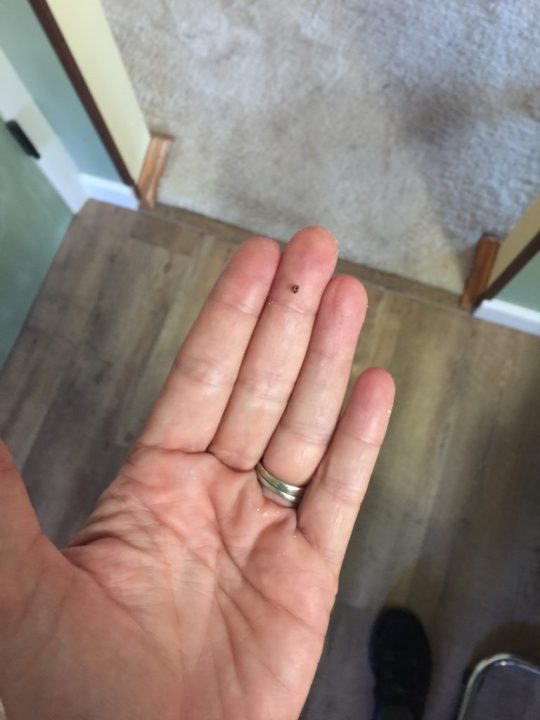



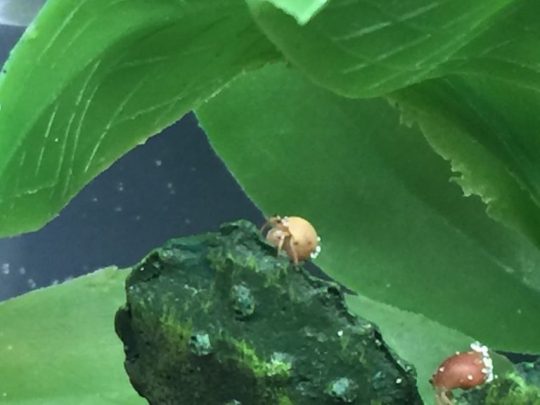
(Pictures all from Mary Akers' site)
More Direct Advocating
Some of these things may require being more involved in the crabby community or going out of your way with time & materials. If you want to advocate in person with events & pet stores, make sure you stay polite, friendly, and helpful! LHCOS aims to educate people without making them defensive or alienating others from our mission.
- Talk to pet stores in your area. See if they're willing to check out LHCOS, or make some changes to improve the store set up. Chain stores may be more limited with this, but it's worth a try. Independent pet stores may be willing to listen & learn about what supplies to promote over others, or even to avoid carrying hermit crabs at all. CSJ has printable info sheets you can offer, including a pet store appeal letter.
- Spread care information. On Craigslist in the pet section, on Facebook, on other social media. Make a post in your neighborhood FB group about not buying crabs at the beginning of the summer. I know someone who recently started putting business cards with LHCOS info next to the hermit crab supplies in chain pet stores. Hand out info at local pet events in your town!
- Contact people in charge. Hermit crabs are often still used as prizes at carnivals and fairs, and crab races are sometimes included at these events. If you hear about an event doing this, contact those in charge and try to educate them. Ask them to cancel or discontinue the use of hermit crabs in these things. It's especially prevalent around beach towns. We have a group member who has tried for years to get a Miss Crustacean Pageant in her area to stop exploiting hermit crabs, but no luck yet. But she still goes every year to hand out care information to whoever will take it.
- Attend Crab Con! It's absolutely amazing. You can get lots of great deals on food, supplies, & hermit crab merch, and spend the whole weekend learning & talking about hermit crabs! What's not to love? It's going to be in person in Virginia in 2023, but there will be an online part as well, for everyone who can't make the trip!
- Rescue crabs in your area! Check craigslist, kijiji, and similar sites. Facebook banned animal sales, but I still found my new crab on marketplace. Just be prepared to deal with crabs in poor condition - look up the Post Purchase Death Reduction method and learn what to do for limb loss, surface molts & naked crabs.
- Adopt crabs from the LHCOS adoption program, or adopt captive bred babies. This can be a great way to get crabs that are healthier than rescues. If you're able to adopt from those who do a lot of rescue work, you also free up space for them to help more crabs in need. Adopting captive bred babies obviously helps support the breeding program. Plus, you get hermit crabs that have never been abused or neglected! They've been loved & cared for since day 1. Just make sure you join the FB group for baby crab owners! They have some specific needs that are a bit different from bigger crabs.
- Volunteer with LHCOS. This is one where you'll need to be in the community for some time first, and you'll need to be reliable. But if you're really interested in hermit crabs and want to get involved, you can look into becoming a local representative for the organization, or becoming one of the educational people who go to reptile shows with a LHCOS booth. There may be other areas that need help, but Stacy would be the one to contact about that once you've been around a bit.
- Donate! Saved this for last bc there's a bunch of different places and ways you can donate. All of these are important parts of the overall mission!
Mary Akers, founder of Hermit House Captive Breeding
Darcy Madsen, certified breeder with Hermit House & runs Crab Central Station YouTube (second link is their website)
Land Hermit Crab Owners Society
Claws in the Classroom, you can donate money through the LHCOS PayPal above, or you can contact Stacy/LHCOS about donating supplies.
Shell donations - The Classroom program can often use shell donations to give teachers. There are also 3 different people who currently work to provide wild hermit crabs with safe shells in Taiwan, Japan, and Florida, USA! Scroll down that link for their addresses.
Painted shells - you can donate these for use with educational booths with the address listed here.
LHCOS & Mary also have stores where they sell hermit crab supplies & merch, if you want to grab some cool stuff while supporting them! The other stores on that list all sell safe hermit crab supplies, and many of us do rescue, advocacy, & donate to CITC as well.
I know this was a LONG answer, but there's just so many ways to make a difference for hermit crabs! It takes an army to stand up for these amazing little guys. I hope this helps and you can join me in being known as a weird hermit crab person!!

#hermit crabs#land hermit crabs#invertebrates#conservation#petblr#wildlife trade#wildlife conservation#long post#land hermit crab owner Society#hermit crab breeding#hermit crab advocating#gif warning
804 notes
·
View notes
Text
Bros, I'm sick to death of the inordinate hatred that people are taking to animals like pandas, koalas and the like (mostly the former) to the level that they legitimately look for any reason (however cherrypicking and incomplete) to wish for their extinction. And all because of memes and "information" channels that have fed a lot of myths and stupidity.
I've had to read things like it's the pandas' fault for not adapting in time and other animals have made it. Because of course, it is perfectly possible to adapt in less than a hundred years to the loss of the ecosystem with which you evolved for millennia and the mass murder of your species. (ALSO, they will never give you an example of those cases where some species did manage to "adapt in time" because they literally do not exist).
I even received the most imbecilic comment of all saying that in a million years they are going to be extinct anyway and that's why it is not worth protecting them...(Wtf)
These people are seriously beyond me, then they contradict themselves or really don't know how to argue as you may have seen, but then they treat you like an idiot for using common sense.
I'm tired people, I am.
76 notes
·
View notes